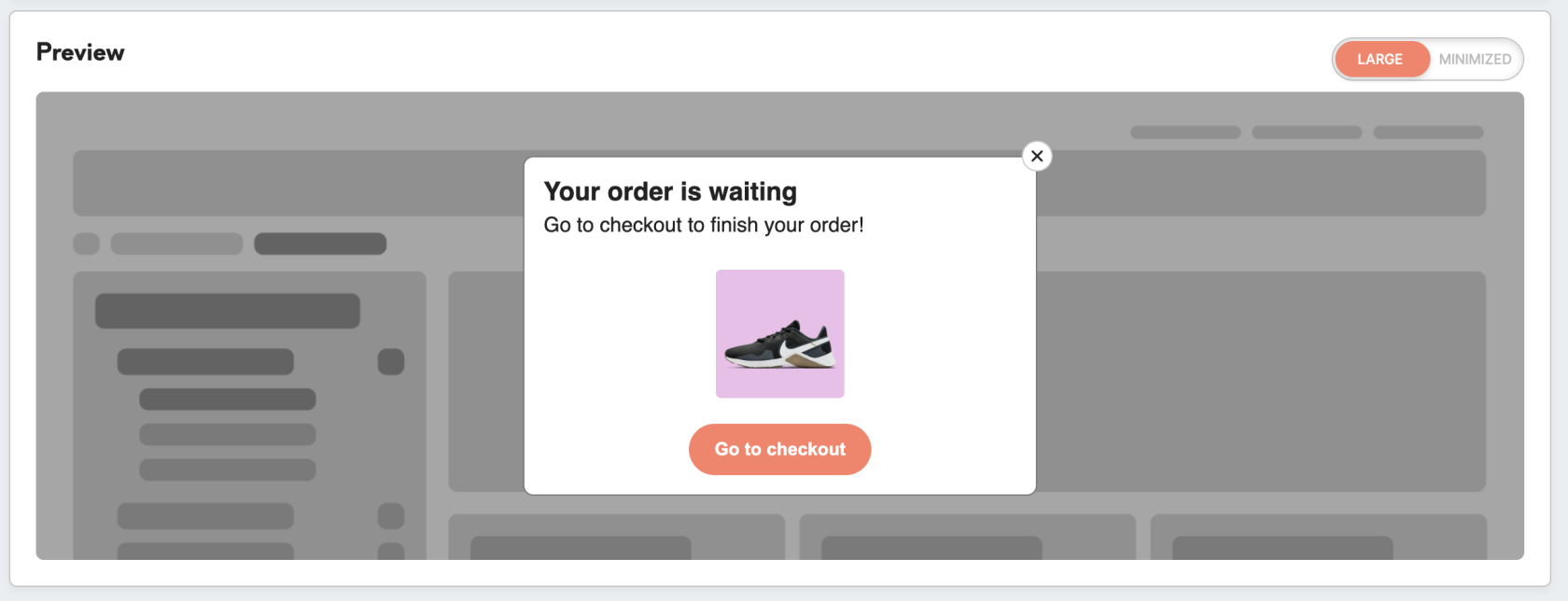Web banners: use cases library (HTML for abandoned basket)
|
Prerequisites To work with web banners, first, they need to be set by the Meiro team: 1. Meiro Events must be implemented. 2. Meiro Events API connection must be set in the Administration/ Settings tab. 3. Web banners tabs must be enabled by the administrator for your user role. 4. For embedded web banners it is required to place a DOM element with a unique ID in the HTML code of the website where the banner will be displayed. To use abandoned basket template, there are additional requirements:
|
Warning: This use case covers data information stored under API. If you store data information in cookies or local storage, more code changes will be required. Turn to the Meiro team for help.
Warning: please stay in touch with the Meiro team when setting this web banner up.
Remember: preview will be loaded dynamically from the HTTP request. Example below.
1. The use case that can be covered
The goal of an abandoned basket template is to show the customer a product, which was recently added to the shopping basket but was not purchased. Web banners will remind the customers of their purchase intention and guide them to finish the checkout process. At least 30 minutes should pass after the customer adds the product into the basket and before he sees a web banner. If many products were added to the basket and not purchased, the user can settle individually on which product will be shown in the web banner (e.g. show the last added product to the cart, show the product with the highest price, etc).
2. Example of conditions to set
Warning: Please keep in mind that each client may have a different setup. Below is just an example of the possible setup. For more details, please contact the Meiro team.
1. Check that the basket cookie is set and does not equal to [].
2. Check that the timestamp cookie is set and is at least 30 minutes old.
3. Select conditions with HTTP requests, insert URL (example https://my-store.com/product_api?items={{cookie:YourBasketCookieName}}) and check that the path to the first element of the product array is set. For example: in the response, there is an array called 'products', check that the path 'products[0]', is set (the first element of the products array exists, the array is not empty).
4. Add any other conditions needed (e.g. exclude the path to the checkout itself).
3. Variables
Variables that are highlighted in the HTML code are dependent on the structure of the response to HTTP conditions and it is possible to adjust them to custom use cases.
Example of variables in the HTML template:
- checkoutURL - is an URL where the user will be directed after clicking on the web banner.
- getProductFromResponse - is a function that extracts the product information from the response and returns results, depending on what data is stored under API.
4. HTML code:code
<!DOCTYPE html>
<html lang="en">
<head>
<meta charset="UTF-8" />
<meta name="viewport" content="width=device-width, initial-scale=1.0" />
<style>
body {
margin: 0;
font-family: sans-serif;
color: #222222;
}
.banner {
display: flex;
flex-direction: column;
align-items: center;
box-sizing: border-box;
width: 100%;
cursor: pointer;
border-radius: 8px;
padding: 15px;
border: 1px solid #777777;
background-color: white;
}
.text-container {
align-self: stretch;
}
.text-container h1 {
margin: 0;
font-size: 20px;
font-weight: 600;
}
.text-container p {
margin-top: 5px;
}
#product-thumbnail {
width: 100px;
margin: 10px;
border-radius: 4px;
}
#product-name {
font-size: 12px;
font-weight: 500;
}
.cta-button {
height: 40px;
border-radius: 20px;
cursor: pointer;
border: none;
margin-top: 10px;
padding: 0 20px;
background-color: #fe7f66;
color: white;
font-size: 14px;
font-weight: 600;
transition: all 0.15s ease;
}
.cta-button:hover {
background-color: #eb6c52;
}
</style>
</head>
<body>
<div class="banner" onclick="goToCheckout()">
<div class="text-container">
<h1>Your order is waiting</h1>
<p>Go to checkout to finish your order!</p>
</div>
<img id="product-thumbnail" src="https://www.meiro.io/pdf/web-layers/nike-shoes.jpg" />
<div id="product-name"></div>
<button class="cta-button">Go to checkout</button>
</div>
<script>
var checkoutURL = "https://www.example.com"
var getProductFromResponse = function (response) {
const product = response.data.data.cart.items[0].product
return { imgSrc: product.thumbnail.url, name: product.name }
}
function goToCheckout() {
if (window.parent && window.parent.MeiroEvents) {
window.parent.MeiroEvents.goToWebBannerUrl(checkoutURL)
}
}
if (window.parent && window.parent.MeiroEvents) {
var bannerID = window.parent.MeiroEvents.getWebBannerId()
var responses = window.parent.MeiroEvents.getWebBannerHttpResponses(bannerID)
var product = getProductFromResponse(responses[0])
document.getElementById("product-name").textContent = product.name
document.getElementById("product-thumbnail").setAttribute("src", product.imgSrc)
}
</script>
</body>
</html>
